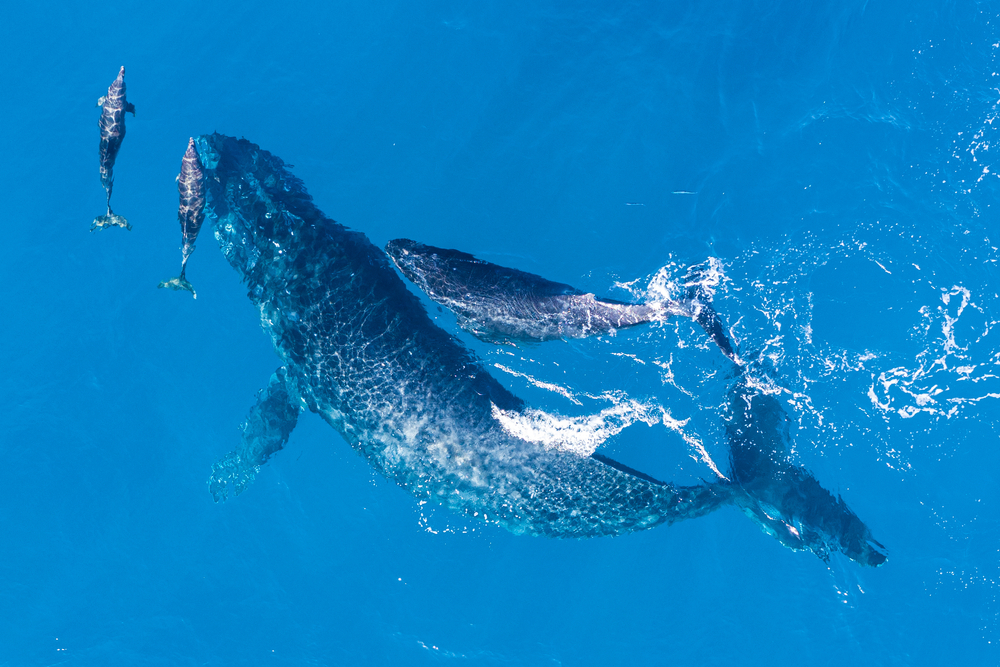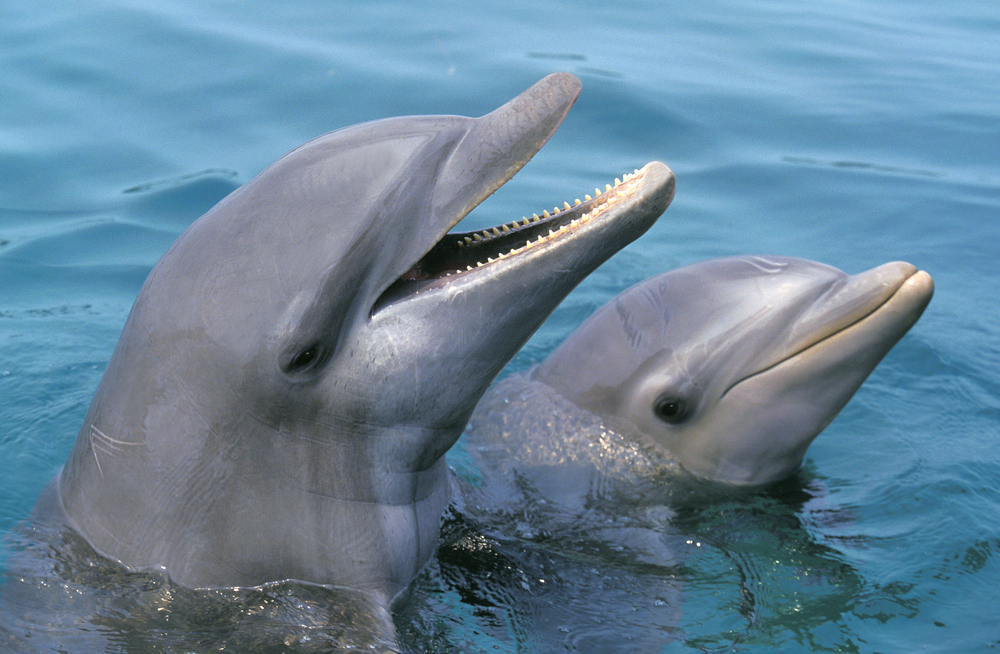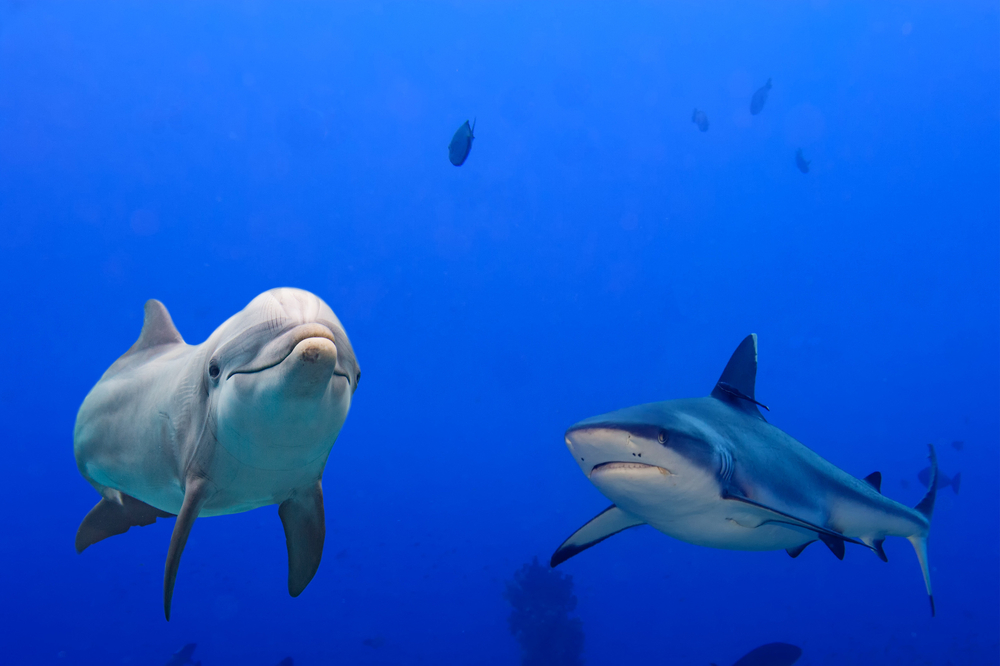Table of Contents (click to expand)
Dolphins do engage in altruistic behavior, but they don’t dish it out for free. They’ve been known to help out other dolphins, whales, and even humans.
Let’s consider an incident from 2011. Two ecologists from the Leibniz Institute of Freshwater Ecology and Inland Fisheries in Germany were surprised to observe a series of peculiar interactions between a bottlenose dolphin and a pod of sperm whales.
Now, in general, bottlenose dolphins are very social creatures. They’ve been known to interact with multiple species of animals, such as rough-toothed dolphins, gray whales, and humpback whales.
Sperm whales, on the other hand, are a shy species. They’re placid mammals who mostly opt out of interacting with other species of animals. So, when these two species of marine mammals teamed up, their interactions confused the heck out of researchers.
The interactions were observed over a period of eight days off the coast of Portugal. The researchers noticed that a bottlenose dolphin was seemingly adopted into the pod of sperm whales. This particular dolphin happened to suffer from a spinal deformity.

Due to the deformity, the dolphin could not swim at the same pace as members of its own pod, but it could swim with the slower sperm whales. The dolphin swam, foraged, and played with members of the sperm whale pod for as long as the ecologists observed it.
Another incident in 2008 involved another group of whales and another bottlenose dolphin. Two pygmy whales had been stranded on a beach in New Zealand. Conservation officers tried desperately for two hours to lead them back into deeper waters.
The bottlenose dolphin, through no external coercion or influence, decided to “help” the two whales. Within half an hour, the dolphin had managed to lead the whales back into the waters.
Never before had this specific inter-species pairing been observed.
Bottlenose dolphins have specifically been known to engage in seemingly unexplainable behaviors. They seem to be ever-present constants in a rich history of reports indicating or recording their altruistic tendencies. So, what is it about bottlenose dolphins that makes them engage in such behaviors?
Do All Dolphins Engage In Altruism?
Delphinidae, as a family, in particular, has been a major proponent of a practice known as reciprocal altruism. How does reciprocal altruism work? Let’s consider the following situation.
Animal A helps animal B. Animal A does not immediately expect rewards from animal B, but rather hedges its bets for a future possibility of a reward from Animal B.
It is easy to accept reciprocity in altruistic behaviors within populations of the same species, like vampire bats or impalas. It boosts evolutionary mechanisms, like kin selection, within the population.

However, how does altruism make sense for inter-species interactions? After all, kin selection doesn’t work for populations that are not genetically compatible with each other.
Think of it like this, in a population of vampire bats, altruism enables kin selection that always works to increase the overall fitness of the vampire bat population.
Now, think of the bottlenose dolphin helping out the two pygmy whales. The dolphin gains no immediate personal reward, nor does it boost the overall fitness of its population.
Also Read: Why Do Animals Help Each Other?
So, What Drives Them Into Such Interactions?
A lot comes down to the common aspect of higher intelligence amongst members of the Delphinidae family. They’re smart enough to be “self-aware” or possess “a theory of mind”. This enables them to isolate incidences of altruism as conscious efforts of maintaining and manipulating channels of communication between themselves and other animals.
Think of it like this, dolphins treat altruism as tit-for-tat incidences. If a dolphin helps you out, odds are it will probably remember helping you out, and if in a bind, it could check and see if you would return the favor. If you don’t, it will stop helping you out.

We can see this with sharks and dolphins. Dolphins are generally antagonistic to sharks, and even when sharks are stuck in a bind (like a literal fishing net, for example) dolphins aren’t too fussed in terms of helping them out.
In a sense, dolphins have evolved to favor reciprocal altruism in a way that is similar to humans. Humans aren’t completely altruistic in our interactions, but we are aware that we can use altruistic behaviors to our benefit. Even if humans do engage in purely altruistic interactions with no ulterior motives, we are aware that it does benefit us on some level.
A Final Word
Dolphins do engage in altruistic behaviors, but they don’t dish it out for free. They’ve been known to help out other dolphins, whales, and even humans, but we rarely see them helping out animals like sharks, which have a known antagonistic relationship with them.
They’re highly intelligent and social animals that have a complex method of “punishing” animals with a recorded history of antagonism (such as sharks) versus “rewarding” animals with a recorded history of cooperation and cooperation (such as whales or other dolphins).
Maybe dolphins are just genuinely helpful for the heck of it, or perhaps they engage in helpful behaviors to create a sort of “tit-for-tat” score card… we don’t conclusively know yet.
What we do know is that we’re just beginning to scratch the surface in terms of research conducted on inter-species behaviors, altruistic and otherwise!
Also Read: Can We Communicate With Dolphins?
How well do you understand the article above!

References (click to expand)
- (2017) Essay Bestial boredom: a biological perspective on animal .... ScienceDirect
- (2003) Biological Altruism - Stanford Encyclopedia of Philosophy. Stanford Encyclopedia of Philosophy
- Biological Altruism: Why Do Animals Help Each Other?. Carolina Biological Supply Company
- Wilkinson, G. S. (1990, February). Food Sharing in Vampire Bats. Scientific American. Springer Science and Business Media LLC.
- Connor, R. C., & Norris, K. S. (1982, March). Are Dolphins Reciprocal Altruists?. The American Naturalist. University of Chicago Press.
